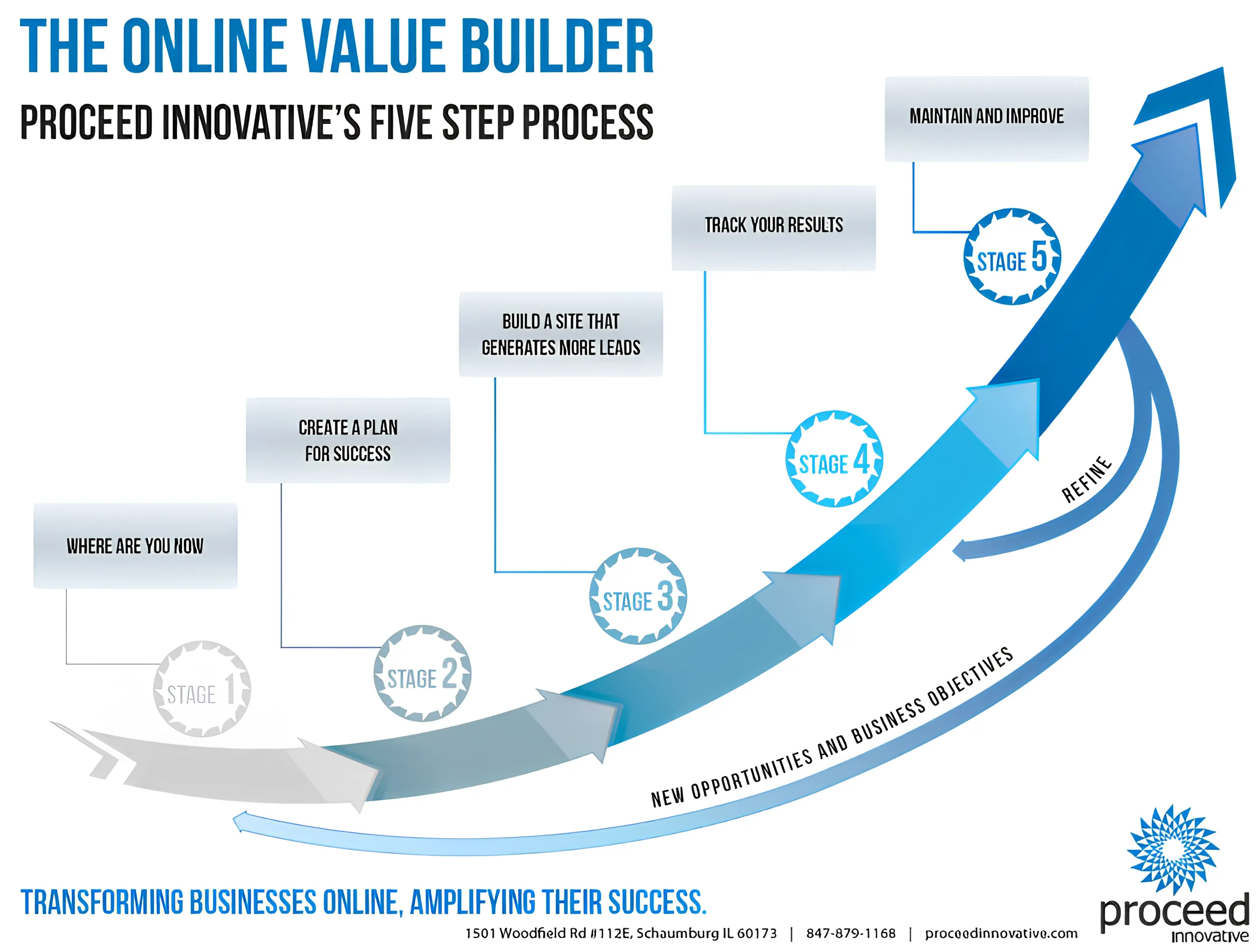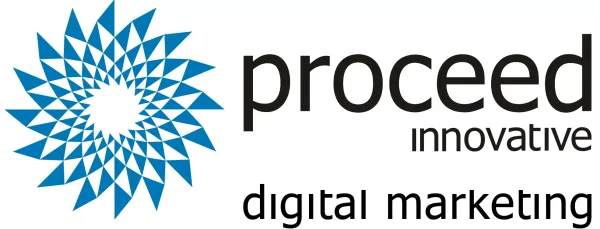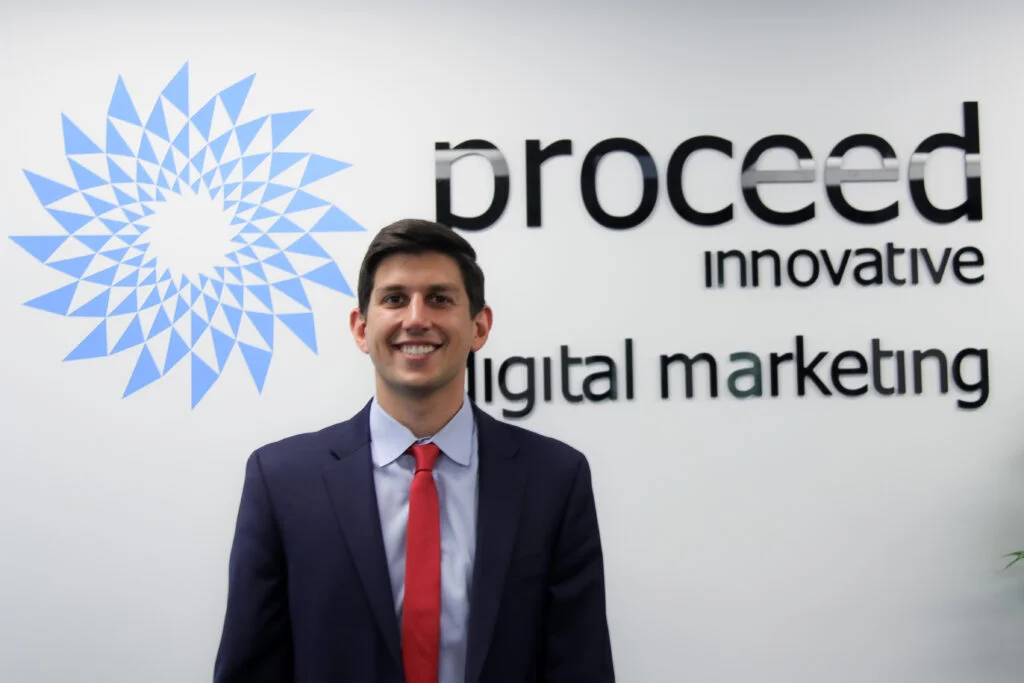Digital Marketing Services
At Proceed Innovative, our team of experienced digital marketing professionals is committed to helping your business grow with a strategy tailored to your goals, audience, and industry. We don’t believe in one-size-fits-all solutions—because your business deserves more than a template.
In today’s competitive landscape, traditional marketing isn’t enough. Your customers are online, searching for answers and solutions. If they can’t find you, they’ll find your competitors. That’s where we come in.
We build custom internet marketing strategies designed to:
Increase your visibility in search engines
Drive qualified traffic to your website
Convert visitors into leads and customers
Whether you’re a startup, small business, or large B2B organization, we provide end-to-end digital marketing services in Chicago that scale with your business. From SEO and paid advertising to website design and analytics, we help you stay visible, competitive, and ready to grow.
Importance of Digital Marketing

With millions of searches happening every day, search engines offer countless opportunities for businesses to connect with potential customers, generate leads, and drive sales. However, building and maintaining a strong online presence is no easy task. It requires continuous effort—researching the market, implementing strategies, monitoring performance, and refining campaigns to stay ahead of the competition. Effective digital marketing is a long-term investment that demands both expertise and consistency to deliver measurable results.
Proceed Innovative is a trusted digital marketing agency based in Schaumburg, IL, serving businesses in Chicago and across the country since 2008. As a certified Google Partner, we follow industry best practices to help businesses improve visibility, increase web traffic, and convert visitors into loyal clients. Our team of experienced professionals provides ongoing support, strategic guidance, and customized solutions in SEO, PPC, website optimization, and more—designed to help your business grow and compete online with confidence.
Why Proceed Innovative
Since 2008, Proceed Innovative has proudly partnered with businesses nationwide to strengthen their digital presence and drive measurable growth. We take pride in helping our clients expand their reach online, generate new leads, and create real sales opportunities through smart, effective digital marketing strategies. Our success is built on a strong foundation of values that guide everything we do—both in how we serve our clients and how we operate as a team.
Our core values include:
Being effective, efficient, and results-driven
Demonstrating passion for our work and our clients’ success
Pursuing growth, learning, and innovation
Keeping our commitments—to our clients and to our team
Building a financially strong, profitable business
Creating a fun, collaborative, and inspiring place to work
As we live by these core values everyday, we know we wouldn’t be where we are today without them. It is these values that allow us to help our clients grow their business through effective and efficient digital marketing services. Our online marketing services can include any of the following:
SEO – Search Engine Optimization (Organic Search)
Designed for long-term success and continuous growth of your business, SEO is the neverending process of website optimization in which our proven strategies are applied and refined to keep your website on top of the SERPS. Our internet marketing experts follow a proven process that has resulted in continuous success for our clients; this includes keyword and competitive research, on and off-page optimization, directory submissions, online reporting and ongoing refinement. They also stay updated on new and updated search engine algorithms so your website always provides the best user experience on all devices.
PPC – Pay Per Click Management
PPC stands for pay-per-click, a model of internet marketing in which advertisers pay a fee each time one of their online ads is clicked. You can have online ads on search engines like Google, social media sites like Facebook, YouTube and many other websites. Google Ads can be set up quickly and turned on and off easily, but difficult to generate your return on investment (ROI). Similar to SEO, pay-per-click (PPC) management requires research, targeted keywords and ongoing refinement to help you rank above your competitors and generate leads. The biggest benefits include the ability to turn the campaign on and off as well as choose your own budget and targeted area. Our PPC professionals are skilled in creating targeted, optimized campaigns with ads that accurately reflect your business to generate qualified leads when you are ready.
WordPress Web Design and Management
Studies have shown that a website should be re-designed every 5-6 years to maintain a fresh, modern appearance. Technology improvements, industry demand, customer expectations, business changes are some of the many reasons to redesign your website. A fresh, new design on your website will reflect a modern, professional outlook on your business, showing customers that you are active online and ready to respond when needed. Our professionals have years of experience in building fast, mobile-friendly websites that allow users to easily navigate and find what they need. We will also work with you every step of the way to create a website that best represents your business and values, one that you are proud to call yours.
Local SEO – Search Engine Optimization
One aspect of SEO marketing that has grown in importance over the years is local search engine optimization to help capture the local market. The majority of searches done for products and services are local in nature as users are looking for a business near them, and about 80% of local searches result in the user taking the desired Call to Action. With the growing popularity of Google My Business and other directories, your local listings are the new face of your online business, and your website is the meat behind them. When both are well-optimized and clearly visible online, your customers can easily find what they need and convert. This in turn will allow you to focus on what you do best while increasing your return on investment.
Mobile SEO – Search Engine Optimization
As the future of marketing relies on mobile devices, having a mobile-friendly website has never been more important. Mobile SEO refers to the search engine optimization of websites combined with flawless viewing on mobile devices, such as smartphones and tablets. Google is already favoring mobile friendly sites. Mobile device usage has skyrocketed in the past few years and is only expected to increase as smart devices become more accessible. Having a mobile-friendly responsive website that is well optimized for search engines is a must for a business of any size.
Lead Generation
One of the biggest challenges in running a business is generating sales leads. But when working with Proceed innovative, we can help with this process by using proven digital marketing strategies to generate qualified leads for you to turn into sales. We specialize in B2B lead generation services in Chicago, with proven methods to increase qualified traffic and drive measurable ROI. Each lead is sent directly to you, either by phone calls or forms, allowing you to focus on what you do best and serve your customers. Each lead is also exclusive, meaning the lead is sent to you and only you, so you have the best chance at making the sale.
Web Analytics Consulting
Because internet marketing campaigns are multi-faceted with several strategies going at once, measuring the success of the campaign can be quite complex. Traditionally, clicks, page views, and search engine rankings were sufficient to measure the success of an internet marketing campaign but the expansion of internet marketing strategies along with the ever evolving nature of the internet requires more in-depth analytics to measure the success. Our experts at Proceed Innovative use a variety of third party reporting and analytics tools to measure the performance of each tactic used in your SEO campaign. We offer a consultative approach in which we help you analyze the statistics and make adjustments to your campaign to help better meet your marketing goals. The internet marketing team at Proceed Innovative has been helping businesses create and implement cost effective internet marketing campaigns for over a decade. Our analytics and digital performance reporting Chicago helps CMOs and marketers tie marketing investments directly to business outcomes.
E-mail Marketing
E-mail marketing is one of the best ways to stay connected with your customers. As it’s highly recommended to grow your email list through your website and direct marketing events, an effective email marketing campaign can generate interest and improve your brand awareness. Our digital marketing professionals develop custom, professional email templates that include specific news and details to keep your customers updated on what’s happening in your business. Our custom reports can also include metrics like campaign clicks and click-through-rate to see which content generated the most interest. Proceed Innovative can add email marketing services to boost your SEO campaign as needed.
Social Media Marketing
Social media marketing is more than just posting updates—it’s about meeting your ideal customers where they are and creating genuine, consistent interactions that build trust. Whether your audience is active on Facebook, LinkedIn, Instagram, or other platforms, having a targeted social media strategy helps increase brand visibility, drive website traffic, and generate leads.
At Proceed Innovative, we provide social media marketing services in Chicago designed to support your overall SEO and digital marketing goals. We help you identify the right platforms for your business, craft engaging content, and create campaigns that resonate with your target audience.
To take it a step further, our Chicago-based marketing automation experts develop behavior-driven workflows that ensure your message reaches the right audience at the right time.
Other Marketing Services
As part of the above listed services, we also provide:
- Marketing automation
- Content marketing
- Digital PR
We offer end-to-end online marketing services Chicago, from brand strategy to analytics, tailored for results-driven B2B organizations.
Testimonials
























